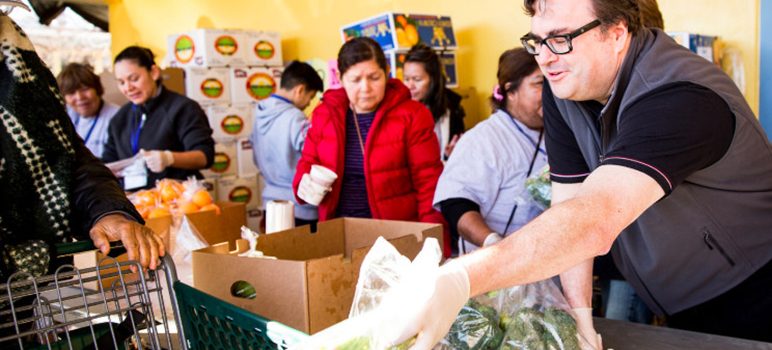As a result of Covid-19 and the subsequent economic downturn, Second Harvest of Silicon Valley is now providing food assistance to an average of 500,000 people every month—twice as many people as it served pre-pandemic.
To help cover increased expenses and to sustain emergency response efforts related to the pandemic, Second Harvest has launched its largest holiday fundraising campaign ever with the goal of raising $30 million by January.
Since the pandemic started, the food bank’s expenses have doubled as it has had to provide more food to twice the usual number of people.
The financial and operational strain of responding to the dramatic increase in need has been further impacted by a 70 percent decrease in the federal government’s contribution of pre-boxed food via the USDA’s Coronavirus Food Assistance Program (CFAP).
Additionally, Second Harvest is experiencing shortages in its vital volunteer workforce, which prior to the pandemic provided more than 250,000 hours of labor a year.
“The holidays will likely look and feel different for all of us this year, but for a huge portion of our community, who were already struggling to make ends meet before Covid-19, they have been hit especially hard by this crisis. They are worried about getting food on the table every day, not just during the holidays,” said Leslie Bacho, CEO of Second Harvest. “A financial donation and a commitment to volunteer can help ensure that everyone in our community can continue to get the nutritious food they need to survive during this incredibly challenging time.”
The economic fallout of the pandemic has hit low wage, hourly workers who were already struggling to afford rent and pay for food in Silicon Valley especially hard. Even before the pandemic, one out of every four people in Silicon Valley was at risk of hunger.
“We’re hearing now that many of the people we are serving during the pandemic have never received help before,” Bacho said. “So many in our community have had to exhaust their savings and are experiencing unstable housing, job setbacks and loss of transportation—they face a potentially long road toward recovery. When you consider this, along with post-recession data, we’re concerned that there may be a significant and permanent increase in the number of people needing food assistance.”
When the need for food assistance first spiked last spring, food banks across the nation issued a call for help and the USDA launched CFAP, which contracted with regional farms and food distributors to supply pre-packed boxes of food directly to food banks across the U.S. through October.
Second Harvest was receiving an average of 38,000 boxes of CFAP food a week, but in November the USDA decreased shipments to 11,000 boxes of food a week for the next three weeks. After that, the program will go away entirely.
The dramatic decrease in CFAP food supply has created additional pressure on Second Harvest to purchase more product and to bring in more volunteers to pack the food.
“We have been incredibly grateful for the support we received from the USDA, but now with that support leaving, we need more community members to step in and help fill that void,” Bacho said in a call for volunteers.
Due to safety concerns and the high level of demand, Second Harvest is not accepting community food donations or distributing food collection barrels into the community this holiday season. Instead, the public is encouraged to make a financial donation; individuals and groups can host a virtual food drive.
Organizers can set a goal, create their own personalized fundraising page with images and videos and then ask their community to donate.
Anyone who needs food can call Second Harvest’s multilingual Food Connection hotline at 800.984.3663 from 8am to 5pm Monday through Friday or visit shfb.org.

